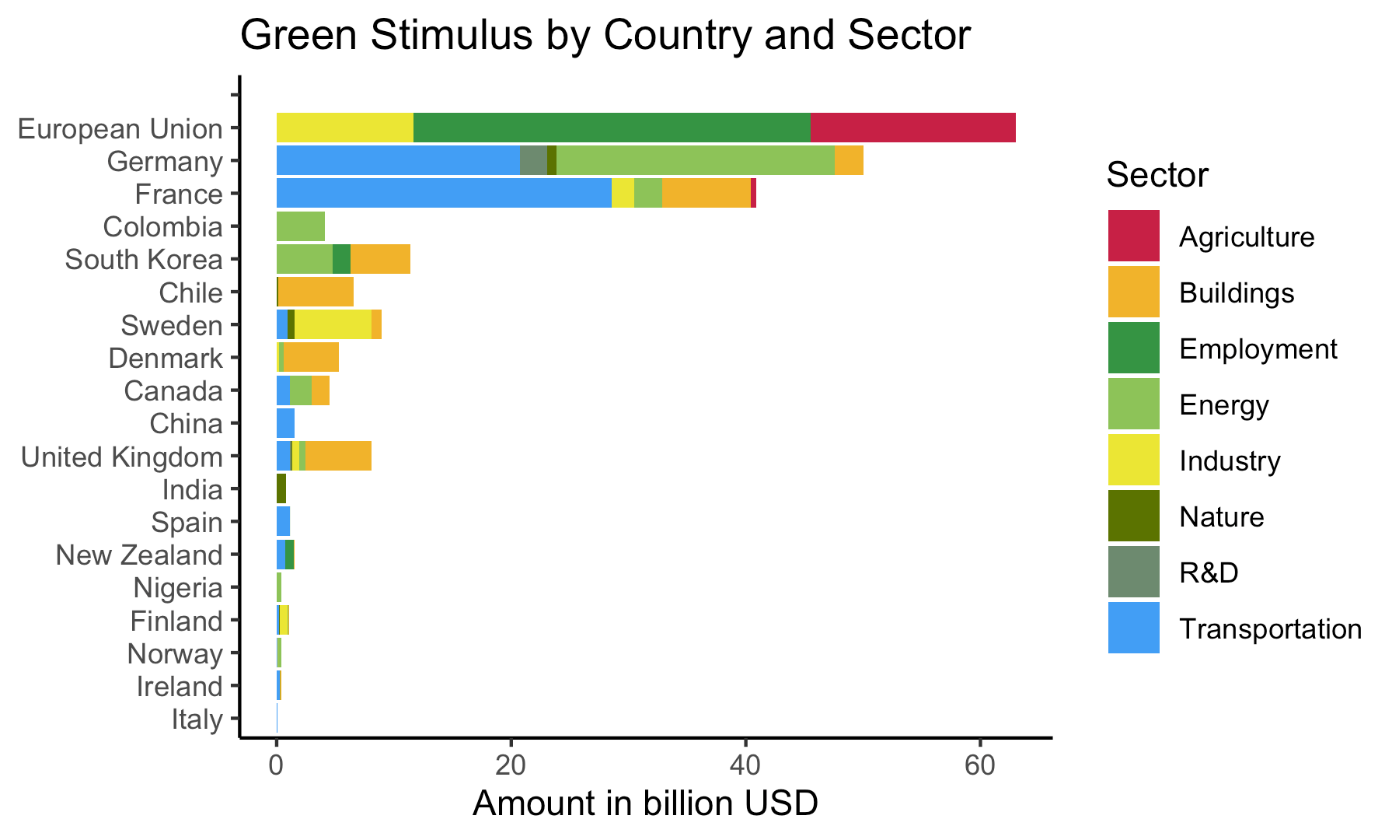
News
Green Recovery for All: How Developing Countries Can Build Forward Better
The COVID-19 pandemic and climate change have one thing in common: given the global scale of these crises, no one is safe until everyone is. Both challenges are transboundary and require joint international efforts to be solved. Governments around the world should thus act in solidarity to engage in a “green recovery.” This development strategy tries ensures social equity, environmental sustainability, and resilience to climate change.
There seems to be wide agreement that no one should be left behind in global green recovery efforts. However, the most recent assessments show that 97% of public spending on post-COVID green recovery is concentrated in OECD countries. This imbalance must be addressed. Even more so, because developing countries are most vulnerable to external shocks such as economic turbulence and public health threats. The economic downturn caused by the pandemic has pushed an additional 71 million people into extreme poverty (defined as having less than USD 1.90 per day) in 2020. The impacts of climate change continue to harm the neglected even more than the rest of the planet. Many developing countries lack basic healthcare systems and climate-resilient infrastructure.

How can policymakers initiate green recovery efforts
Given the lack of fiscal space, initiating a green recovery can be daunting for policymakers in developing and least-developed countries. However, countries need to induce an economically, socially, and environmentally sustainable stimulus. The four steps suggested below can help them find the resources necessary for this.
1) Set clear recovery objectives based on the SDGs
The first step is to integrate the universally agreed United Nations Sustainable Development Goals (SDGs) into the national policy framework for economic recovery and policy responses to COVID-19.[ii] It should be clearly stated that advancing the SDGs is the primary objective of the country’s green recovery efforts. The government must communicate this policy agenda consistently. This would send an unequivocal signal and trigger action in civil society, among business communities as well as domestic and international investors.
“For the COVID-19 pandemic to prove a turning point, climate action and COVID-19 economic stimulus measures must be mutually supportive; and developing countries must be able to access long-term affordable finance to develop and implement green stimulus measures”.[iii]
GCF 2020
2) Use the SDGs as key performance indicators to measure, evaluate, and report on green recovery efforts
Governments need to monitor, report and evaluat transparently the performance and effects of all green recovery actions, based on robust data. This is a prerequisite to hold the public sector accountable and foster participation of the private sector. The 17 SDGs are defined in a list of 169 SDG Targets, and progress towards these targets is tracked by 232 unique Indicators.[iv] It is these indicators that should also be used as key performance measurements for green recovery action. This will enhance alignment of policy actions with broader sustainability objectives and allow both domestic “policy learning” and international support for SDG implementation.
The following example illustrates this approach. A program that aims to stimulate employment must ensure creation of jobs in low-carbon sectors, such as renewable energy, and that the share of female recipients is at least 40-50%.
3) Design sector-specific policies for decarbonization
Decarbonization of carbon-intensive sectors is crucial for long-term green recovery. Since each sector operates in vastly different contexts, sector-specific policies for decarbonization must be in place. In 2020, the OECD has suggested green recovery policy actions for five sectors: agriculture, buildings, electricity, industry, and transport.[v] These can be a useful inspiration for sectoral decarbonization strategies that jointly form a national green recovery plan.
4) Identify funding sources to allocate necessary budgets
A certain portion of public budgets should be earmarked for green recovery. The EU has reserved 30% of its recovery budget for low-carbon activities. Many developing countries, however, face a lack of public finance that is difficult to address domestically. International funding can help to overcome this hurdle. Having a convincing, ambitious, and realistic green recovery plan can be an effective strategy for attracting funders and investors. Climate and SDG-related considerations play an increasing role in determining grant/loan eligibility at multilateral development banks. International public funds such as the Green Climate Fund are making new financing available specifically for green recovery efforts. The DEVEX COVID-19 Recovery Funding Opportunities Mapper can help policymakers navigate possible financing sources for green recovery.[vi]
What investments should we prioritize?
In mid-2020, the LEDS GP Energy Working Group organized a three-part webinar series on assisting developing countries in their efforts to recover from the pandemic. We promoted this series using the hashtag #SDGstimuli to describe the objective of the initiative: to understand how short-term recovery efforts, particularly in the energy and transport sectors, can support long-term transitions towards climate objectives and the SDGs. As discussed in the webinar series, investments in the energy sector can yield enormous impacts. High-potential sectoral action includes: 1) advancing energy access, 2) expanding renewable energy, and 3) improving energy efficiency.
There are several reasons why the energy sector should take a front seat in green recovery efforts (and this is not to say that other sectors should be left behind!). First, scaling up low-carbon energy sources is an effective way to reduce greenhouse gas emissions. It is estimated that we could reduce global CO2 emissions by a staggering 33% if we invested in a clean energy sector for the next 3 years.[vii] The time to act is now! Second, thanks to impressive technological advancements over the last decade, the renewable energy sector can bring higher economic benefits than fossil fuels. Some of theaw benefits include energy cost savings and job creation. Finally, investing in decentralized smart grids has the potential to provide reliable and affordable energy access (SDG 7) to about 270 million people in low-income countries in a relatively short time. This will, in many world regions, precondition significant progress on other SDGs such as poverty, health, and education. The pandemic has emphasized the need to meet SDG 7, as hospitals and healthcare centers cannot function without access to reliable energy sources.
If you want to learn more about this issue, check out this webinar of the EWG and the Africa LEDS Partnership on the importance of energy access for tackling the pandemic:
By viewing the video you agree that your data will be transferred to Youtube
More Information in our privacy policy
Green recovery for All
No country will be safe from the global threats of COVID-19 and climate change until every country recovers sustainably. Policymakers in developing countries and low-income countries can start the green recovery process by integrating SDGs and NDCs in national development strategies. Having a transparent strategy and clear targets in place, and consistently reporting on progress made toward them, will attract new investment including special-purpose green financing. Investing in decarbonization of the energy sector can bring enormous economic and social benefits in relatively short timeframes. Green stimuli packages are a tremendous opportunity for all countries, not just OECD members, to build a fairer, cleaner, and more resilient future for their citizens.
[i] See Carbon Brief Green Recovery Tracker at https://www.carbonbrief.org/coronavirus-tracking-how-the-worlds-green-recovery-plans-aim-to-cut-emissions. Accessed 15 January 2021.
[ii] Akyüz, Y. (2020). Global Economic Prospects, June 2020. In The Financial Crisis and the Global South (Issue June). http://elibrary.worldbank.org/doi/book/10.1596/978-1-4648-1553-9
[iii] GCF. (2020). Tipping or turning point: Scaling up climate finance in the era of COVID-19. https://www.greenclimate.fund/document/tipping-or-turning-point-scaling-climate-finance-era-covid-19
[iv] For a full list of definitions, see https://unstats.un.org/sdgs/indicators/Global%20Indicator%20Framework%20after%20refinement_Eng.pdf
[v] OECD. 2020. 25 Actions on climate. oe.cd/climate25
[vi] DEVEX Dashboard. https://public.tableau.com/profile/devexdevdata#!/vizhome/COVIDFundingvisualisation/COVID-19funding
[vii] IEA. (2020, June). Sustainable Recovery: World Energy Outlook Special Report. https://www.iea.org/reports/sustainable-recovery
Authors:
Uni Lee & Alexander Ochs, SD Strategies, for the LEDS Energy Working Group (EWG)
Disclaimer: The information and opinion expressed on this blog post do not necessarily reflect the views of the LEDS GP Global Secretariat or of the LEDS regional platforms, working groups, communities of practice, and membership.
